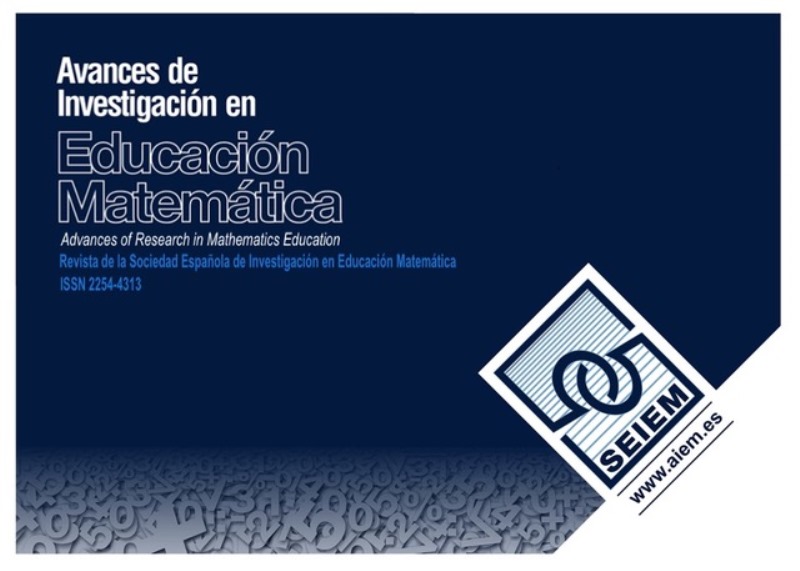Slow Reveal Graphs and Graph Reading Levels in the Formulation of Statistical Problems
DOI:
https://doi.org/10.35763/aiem28.7549Keywords:
Graph reading levels, Initial teacher training, Problem posing, StatisticAbstract
Problem posing promotes problem comprehension and solving, but its application in statistics is limited in the literature. This study analysed how 164 Pre-service Teachers (PSTs) posed statistical problems based on graph reading levels, following the Slow Reveal Graphs approach. The results showed that the PSTs were able to contextualise their proposals, align them with the curriculum, and use appropriate language, but they made errors in identifying the graph reading levels. The study represents a novel line of inquiry in statistical education, highlighting ways to strengthen the didactic-mathematical knowledge of PSTs in problem posing and graph reading levels.
Downloads
References
Abaev, D. (2022, 30 de noviembre). The Best European City for McDonald’s According to Google Maps Reviews [Entrada de blog]. Slow Reveal Graphs. https://slowrevealgraphs.com/2022/11/30/the-best-european-city-for-mcdonalds-according-to-google-maps-reviews/
Aldrich, F., & Sheppard, L. (2001). Tactile graphics in school education: Perspectives from pupils. British Journal of Visual Impairment, 19(2), 69–73. https://doi.org/10.1177/026461960101900204
Alsina, Á., & Vásquez, C. (2024). Itinerarios de enseñanza de la estadística (3-12 años): Una herramienta para el diseño de tareas. UNO, 104, 8–14.
Alsina, Á., Vásquez, C., Muñiz-Rodríguez, L., & Rodríguez-Muñiz, L. J. (2020). ¿Cómo promover la alfabetización estadística y probabilística en contexto? Estrategias y recursos a partir de la COVID-19 para Educación Primaria. Épsilon, 104, 99–128.
Anderson, L. W., & Krathwohl, D. R. (2001). A taxonomy for learning, teaching, and assessing: A revision of Bloom’s taxonomy of educational objectives. Addison Wesley Longman, Inc.
Arnold, P. (2008). What about the P in the PPDAC cycle? An initial look at posing questions for statistical investigation. En M. Santos & Y. Shimizu (Eds.), Proceedings of the 11th International Congress on Mathematical Education (ICME-11) (pp. 1–8). ICMI.
Arnold, P., & Franklin, P. (2021). What makes a good statistical question? Journal of Statistics and Data Science Education, 29(1), 122–130. https://doi.org/10.1080/26939169.2021.1877582
Arteaga, P., Batanero, C., Contreras, J. M., & Cañadas, G. R. (2015). Statistical graphs complexity and reading levels: A study with prospective teachers. Statistique et enseignement, 6(1), 3–23. https://doi.org/10.3406/staso.2015.1301
Bargagliotti, A., Franklin, C., Arnold, P., Gould, R., Johnson, S., Perez, L., & Spangler, D. A. (2020). The Pre-K-12 Guidelines for Assessment and Instruction in Statistics Education II (GAISE II). American Statistical Association.
Burgos, M., Tizón-Escamilla, N., & Chaverri, J. (2024). A model for problem creation: Implications for teacher training. Mathematics Education Research Journal, 37, 55–84. https://doi.org/10.1007/s13394-023-00482-w
Cai, J., & Hwang, S. (2020). Learning to teach through mathematical problem posing: Theoretical considerations, methodology, and directions for future research. International Journal of Educational Research, 102, 1–8. https://doi.org/10.1016/j.ijer.2019.01.001
Cai, J., & Hwang, S. (2021). Teachers as redesigners of curriculum to teach mathematics through problem posing: Conceptualization and initial findings of a problem-posing project. ZDM Mathematics Education, 53, 1189–1206. https://doi.org/10.1007/s11858-021-01309-3
Cai, J., & Leikin, R. (2020). Affect in mathematical problem posing: Conceptualization, advances, and future directions for research. Educational Studies in Mathematics, 105, 287–301. https://doi.org/10.1007/s10649-020-10008-x
Cañadas, M. C., Molina, M., & del Río, A. (2018). Meanings given to algebraic symbolism in problem-posing. Educational Studies in Mathematics, 98, 19–37. https://doi.org/10.1007/s10649-017-9797-9
Chapman, O. (2012). Prospective elementary school teachers’ ways of making sense of mathematical problem posing. PNA, 6(4), 135–146. https://doi.org/10.30827/pna.v6i4.6137
Chavarría-Arroyo, G., & Albanese, V. (2023). Contextualized mathematical problems: Perspective of teachers about problem posing. Education Sciences, 13(6), 1–15. https://doi.org/10.3390/educsci13010006
Crowther, David. (2024, 12 de noviembre). Netflix Keeps Pulling Ahead of the Competition: Paid Streaming Subscribers, by Platform [Entrada de blog]. Slow Reveal Graphs.
Curcio, F. R. (1989). Developing graph comprehension. NCTM.
Díaz-Levicoy, D., Parra-Fica, J. H., Aravena-Díaz, M., & Gutiérrez-Saldivia, X. (2021). Lectura de gráficos estadísticos por profesores de educación primaria en activo. Información Tecnológica, 32(3), 57–68.
https://doi.org/10.4067/S0718-07642021000300057
English, L. D., & Watson, J. M. (2015). Statistical literacy in the elementary school: Opportunities for problem posing. En F. Singer, N. Ellerton, & J. Cai (Eds.), Problem posing: From research to effective practice (pp. 241–256). Springer. https://doi.org/10.1007/978-1-4614-6258-3_11
Friel, S., Curcio, F., & Bright, G. (2001). Making sense of graphs: Critical factors influencing comprehension and instructional implications. Journal for Research in Mathematics Education, 32(2), 124–158. https://doi.org/10.2307/749671
Instituto Cántabro de Estadística (2025). Censo de Ganado. Consejería de Desarrollo Rural, Ganadería, Pesca y Alimentación. Gobierno de Cantabria. https://www.icane.es/data/cattle-exploitation-municipal
Instituto Nacional de Estadística (2023a). Fenómenos demográficos por tipo de fenómeno demográfico.
https://www.ine.es/jaxiT3/Datos.htm?t=6566#_tabs-grafico
Instituto Nacional de Estadística (2023b). Viajeros por motivos personales 2024.
Instituto Nacional de Evaluación Educativa. (2022). Marco para pruebas de matemáticas. PISA 2022. OCDE.
Leavy, A., & Frischemeier, D. (2022). Developing the statistical problem posing and problem refining skills of prospective teachers. Statistics Education Research Journal, 21(1), 1–27. https://doi.org/10.52041/serj.v21i1.226
Leavy, A., & Hourigan, M. (2022). The framework for posing elementary mathematics problems (F-PosE): Supporting teachers to evaluate and select problems for use in elementary mathematics. Educational Studies in Mathematics, 111, 147–176. https://doi.org/10.1007/s10649-022-10155-3
Lee, E. J., & Park, M. (2019). Statistical reasoning of preservice elementary school teachers engaged in statistical problem solving: Focused on question posing stage. Education of Primary School Mathematics, 22(4), 205–221.
Liljedahl, P., & Cai, J. (2021). Empirical research on problem solving and problem posing: A look at the state of the art. ZDM Mathematics Education, 53, 723–735. https://doi.org/10.1007/s11858-021-01291-w
Makar, K., & Fielding-Wells, J. (2011). Teaching teachers to teach statistical investigations. En C. Batanero, G. Burrill, & C. Reading (Eds.), Teaching statistics in school mathematics—Challenges for teaching and teacher education (Vol. 14, pp. 347–358). Springer. https://doi.org/10.1007/978-94-007-1131-0_33
Mallart, A., Font, V., & Diez, J. (2018). Case study on mathematics pre-service teachers’ difficulties in problem solving. Eurasia Journal of Mathematics, Science and Technology Education, 14(4), 1465–1481. https://doi.org/10.29333/ejmste/83682
Martín-Díaz, J. P., & Montes, M. (2022). Conocimiento especializado para la enseñanza a través de la formulación de problemas en educación infantil. Uniciencia, 36(1), 1–19. https://doi.org/10.15359/ru.36-1.37
Melo, M. F. (2023, 8 de agosto). Las mascotas preferidas por los españoles [Entrada de blog]. Statista.
https://es.statista.com/grafico/30552/cantidad-de-mascotas-en-espana/
Ministerio de Educación y Formación Profesional. (2022). Real Decreto 157/2022, de 1 de marzo, por el que se establecen la ordenación y las enseñanzas mínimas de la Educación Primaria. Boletín Oficial del Estado, 52 (2 de marzo de 2022), 24386–24504.
Muñiz-Rodríguez, L., Rodríguez-Muñiz, L. J., & Alsina, Á. (2020). Deficits in the statistical and probabilistic literacy of citizens: Effects in a world in crisis. Mathematics, 8(11), 1872. https://doi.org/10.3390/math8111872
National Council of Teachers of Mathematics. (2000). Principles and standards for school mathematics. NCTM.
Rodríguez-Muñiz, L. J., Muñiz-Rodríguez, L., & Aguilar-González, Á. (2021). El recuento y las representaciones manipulativas: Los primeros pasos de la alfabetización estadística. PNA, 15(4), 311–338. https://doi.org/10.30827/pna.v15i4.22511
Rodríguez-Muñiz, L. J., Muñiz-Rodríguez, L., García-Alonso, I., López-Serentill, P., Vásquez, C., & Alsina, Á. (2022). Nadando entre dos orillas: Abstracción y contexto en educación estadística en Secundaria. Culture and Education, 34(3), 689–725. https://doi.org/10.1080/11356405.2022.2058794
Rosli, R., Capraro, M. M., & Capraro, R. M. (2014). The effects of problem posing on student mathematical learning: A meta-analysis. International Education Studies, 7(13), 227–241. https://doi.org/10.5539/ies.v7n13p227
Silver, E. A. (1994). On mathematical problem posing. For the Learning of Mathematics, 14, 19–28.
Watson, J. M., & English, L. D. (2017). Statistical problem posing, problem refining, and further reflection in grade 6. Canadian Journal of Science, Mathematics and Technology Education, 17(4), 347–365. https://doi.org/10.1080/14926156.2017.1380867
Wild, C., & Pfannkuch, M. (1999). Statistical thinking in empirical enquiry. International Statistical Review, 67(3), 223–248.
https://doi.org/10.1111/j.1751-5823.1999.tb00442.x
Wilson, L. O. (2016). Anderson and Krathwohl Bloom’s taxonomy revised: Understanding the new version of Bloom’s taxonomy. The Second Principle, 1(1), 1–8.
Downloads
Published
How to Cite
Issue
Section
License
Copyright (c) 2025 Pablo Giadas, Laura Muñiz Rodríguez, Luis J. Rodríguez Muñiz

This work is licensed under a Creative Commons Attribution 4.0 International License.
The articles published in this journal are under a license Creative Commons: By 4.0 España from number 21 (2022).
Authors who publish with this journal agree to the following terms:
- Authors retain copyright and keep the acknowledgement of authorship.
- The texts published in this journal are – unless indicated otherwise – covered by the Creative Commons Attribution 4.0 international licence. You may copy, distribute, transmit and adapt the work, provided you attribute it (authorship, journal name, publisher) in the manner specified by the author(s) or licensor(s). The full text of the licence can be consulted here: http://creativecommons.org/licenses/by-nc/4.0.
- Authors are able to enter into separate, additional contractual arrangements for the non-exclusive distribution of the journal's published version of the work (e.g., post it to an institutional repository or publish it in a book), with an acknowledgement of its initial publication in this journal.
- Authors are permitted and encouraged to post their work online (e.g., in institutional repositories or on their website) prior to and during the submission process, as it can lead to productive exchanges, as well as earlier and greater citation of published work (See The Effect of Open Access).
Funding data
-
Agencia Estatal de Investigación
Grant numbers PID2021-122180OB-100 -
Agencia Estatal de Investigación
Grant numbers PID2024-155358NB-100 -
Universidad de Oviedo
Grant numbers PAPI-22-PF-18









